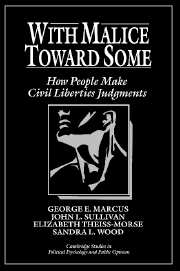Book contents
- Frontmatter
- Contents
- List of Figures and Tables
- Preface: Political Tolerance and Democratic Life
- PART I Theoretical Background and Overview
- PART II Contemporary Information and Political Tolerance Judgments
- PART III Refining the Model – The Role of Antecedent Considerations as Individual Differences
- PART IV Implications and Conclusions
- Appendix A: Hypothetical Group Scenarios and Manipulations
- Appendix B: Methodological Approaches and Scales
- Notes
- References
- Index
PART IV - Implications and Conclusions
Published online by Cambridge University Press: 05 August 2012
- Frontmatter
- Contents
- List of Figures and Tables
- Preface: Political Tolerance and Democratic Life
- PART I Theoretical Background and Overview
- PART II Contemporary Information and Political Tolerance Judgments
- PART III Refining the Model – The Role of Antecedent Considerations as Individual Differences
- PART IV Implications and Conclusions
- Appendix A: Hypothetical Group Scenarios and Manipulations
- Appendix B: Methodological Approaches and Scales
- Notes
- References
- Index
Summary
The final section traces the broader implications of our model of tolerance judgments. Our previous sections have largely focused on tolerance attitudes. While these attitudes are obviously important, it is also essential to tie our study to the wider world of politics and political action.
Chapter 9 focuses on behavior. Because we could not directly measure behavior, we instead rely on behavioral intentions. Many people subscribe to the widespread argument that those who are politically unaware will be passive. A related argument suggests that those who are marginalized, who are less aware, will also be more intolerant. However, we hypothesize that the intolerant who expressed the strongest intention of future action would indeed be most likely to act. We examine who is most likely to act to defend their judgments.
Chapter 10, our conclusion, summarizes and extends our findings and raises several implications of our model. First, our research shows that predispositions, standing decisions, and contemporary information all affect tolerance decisions. Several antecedent considerations make a difference: threat predispositions, neuroticism, gender, expertise, democratic norms, and preexisting tolerance attitudes. Contemporary information also contributes to tolerance judgments, including state of mind, democratic norms, and normative violations. We emphasize the encapsulation effect of democratic norms and tolerance as a standing decision on many other antecedent conditions such as personality and least-liked group threat. Finally, we return to the effect of emotion on decision making and suggest that cognition is not the whole story.
- Type
- Chapter
- Information
- With Malice toward SomeHow People Make Civil Liberties Judgments, pp. 179 - 180Publisher: Cambridge University PressPrint publication year: 1995



